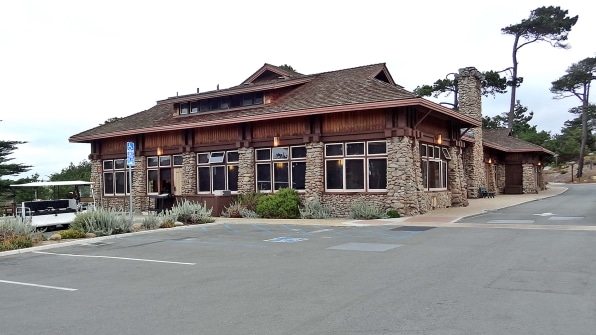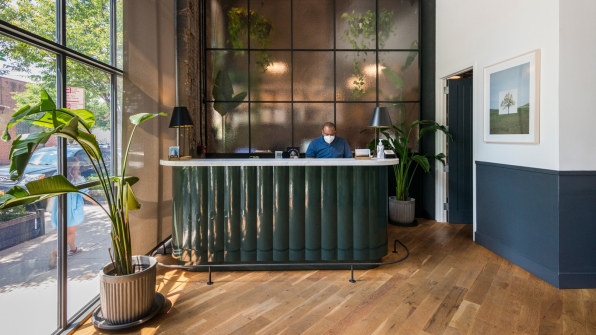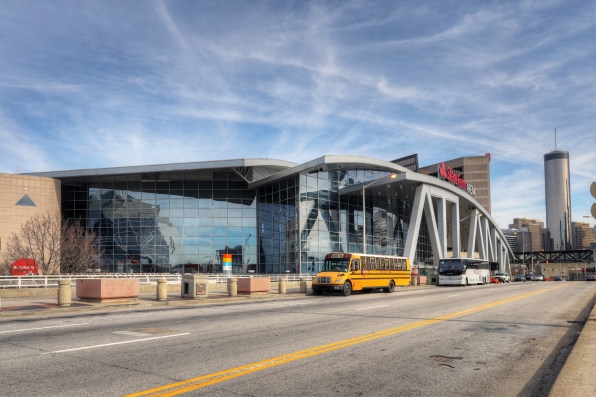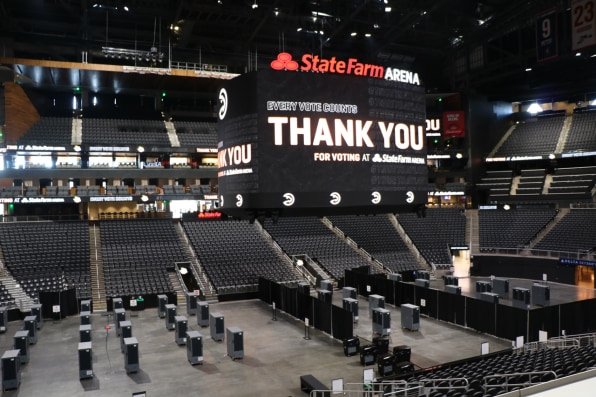How iconic buildings like Dodger Stadium transformed during COVID-19
The pandemic posed an existential crisis for buildings. With a deadly airborne virus, many places became simply unsafe to use, from offices to movie theaters to restaurant dining rooms. If a building stands empty, is it needed at all?
In some cases, the answer is a qualified yes; it just needs a bit of reconsideration. Across the country, buildings that were unsafe for their original intentions suddenly found that, with a little imagination, they could be reborn and reused for completely new purposes. Here are a few of the most significant types of spaces that underwent conversions and changed shape over this pandemic year.
Hotels
Of all the building types struggling with emptiness during the pandemic, hotels may be the hardest hit as virtually all travel has stopped. But not all that hospitality space has gone to waste.

In March, when the extent of the pandemic was still unclear, hotels—including the historic Asilomar hotel and conference center in Pacific Grove, CA—began to take on new lives as isolation spaces for people exposed to the virus. Hotels, motels, and even spaces like vacant school dormitories were seen early on as ideal isolation quarters. At the time, Mike Cook, a partner at the Innova Group, a healthcare planning consultancy, told Fast Company that “private rooms with toilets are priorities number one and number two” for people who may have been exposed to COVID-19.

With overnight stays plummeting as the pandemic dragged on, hotels began trying to provide a new kind of service by reconfiguring into daytime short-term offices. One, a 70-room boutique hotel in Williamsburg, Brooklyn, called the Wythe Hotel partnered with Industrious, a short-term office space provider to turn its loft-style rooms into offices for up to four people, starting at $200 a day. The repurposing of the space, launched in July, was just the first of many such efforts by hotels to wring some extra use out of their spaces by appealing to workers. It was a response to strange times, but perhaps a sign of where the hotel industry is heading, according to Industrious CEO Jamie Hodari. “I think this is something that was long overdue, and this is a first step towards real-world examples of workplace providers and hotel providers becoming a bit more intertwined,” Hodari told Fast Company at the time.
Beyond these kinds of adaptations, hotels may also simply become something else entirely. One project in New York suggests that hotels that don’t survive through the pandemic lockdowns could take on new lives as affordable housing. The social services nonprofit Breaking Ground recently bought a former 29-story hotel and is in the process of converting it into nearly 500 units of permanent supportive housing–a conversion that’s relatively easy, because most hotels already have bathrooms in every room and some have kitchenettes.
There may be more opportunities for this kind of project in the coming months, both in New York and beyond. “With tourism in the city way down because of COVID-19 there are many hotels that are in danger of default, and we see this as a major opportunity to turn some into affordable housing, to help homeless and low-income families,” Breaking Ground’s president and CEO Brenda Rosen told Fast Company.
Sports venues
With major sports mostly halted and crowd-based activities too risky, arenas and stadiums went into off-season mode.
But these massive structures are often designed for multiple purposes, including sports, concerts, and conventions, so many were ready to take on new tasks during the pandemic. One especially important role came in the form of the November general election, when dozens of sports venues opened to the public as voting centers.

At State Farm Arena, the home of the NBA’s Atlanta Hawks, the building turned into a voting place three times in 2020, once for a primary runoff in July, again for the general election in November, and finally in December for the dual runoff for Georgia’s senate seats. Hawks CEO Steve Koonin equates the experiences to the preseason, the regular season and the playoffs. Voting booths were setup on the arena floor and staff were trained to help people safely vote while maintaining social distance. “We learned how to do it,” Koonin says. During its few weeks as an early voting site during the general election, more than 40,000 people voted at the arena. In just the first two days of the December senate runoff, he says, even more voters came out. “It went so incredibly well [during the general election], we just felt that was the right thing to do it again,” he says.

It’s also led to other pandemic-related uses of the building, including a clothing drive and a drive-through distribution of groceries and other aid. Koonin says the experience underscores the potential for these buildings to help local governments improve life for their citizens. “I’m very bullish on the fact that these are civic enterprises,” he says. “Civic goals can be accomplished by using the building, it just takes the right idea and the right people, and we were fortunate to have both.”
Other COVID-19 conversions
As the pandemic drags on, the reuse of spaces is likely to continue, and some of that reuse will be directly related to the COVID-19 disease itself. It’s already happening, with places like Dodger Stadium in Los Angeles turning into well-used if somewhat absurd COVID-19 testing sites.
Now that vaccines have been approved, the process of distributing and injecting them may be creating a new kind of demand for otherwise empty spaces. One example is retail, which has suffered through the pandemic’s lockdowns in addition to the general shift towards online shopping. “One industry that was already starting to fill retail space was the medical industry,” says Pauline Hale, with commercial real estate advisors Altus Group. Vacant storefronts are seeing new lives as neighborhood-focused clinics and urgent care facilities. Hale says these emptied spaces could just as easily become COVID-19 conversions, especially with no clear end to the pandemic in sight. “Do we see COVID test spaces filling up some of this empty retail? Or vaccine clinics, if they have to be annual?” she says.
In the end, almost every building will be a COVID-19 conversion of one type or another, as the use of space and the precautions they require inevitably change the form and function of buildings. Though many impacts of the pandemic are hard to fully predict, one thing seems clear: In the months and years to come, the way we use and experience buildings will be tinged with the memories of when buildings were either unsafe or unnecessary to use.
(22)

